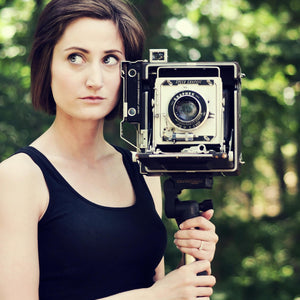-
Lightroom Presets
- Mobile Presets
-
Photoshop
-
Learn
-
Support
-
Install
- Best Sellers
- Blog
By Anna Gay on | No Comments

If you are new to photography, you might find yourself wondering what all of the different numbers, letters, and symbols on your camera lens mean. They may seem complicated at first, but its really easy to understand once explained.
In this post, I will show you a few examples of standard lenses and explain some of the most important numbers and letters you have on your lens.
Millimeters, or "mm" for short, is the standard unit of measurement for the focal length of a lens. So when you see "mm" following a number or a pair of numbers on a lens, you will know that the number refers to the focal length (single number) or focal range (pair of numbers).
Focal length is what you see when you look through your camera viewfinder.
Let's look at an 18-55mm lens as an example. The pair of numbers refers to the focal length range or that particular lens. You can use this lens at its widest angle (18mm), the most zoomed (55mm), or anywhere between 18mm and 55mm.
If any of this is confusing, you can read much more about focal length here:
Here is a 24-70mm lens:

And an 85mm lens:

When you see a 1: followed by a number, this represents the lens's maximum aperture or how wide the opening on your lens is when you take a photo. The smaller the number, the wider the opening (which lets in more light).
In this case, the numbers read 1:2.8, which means that this 24-70mm lens has a wide-open aperture of f/2.8:

In some cases with zoom lenses, you will see two numbers following the "1:", as in the example below, which shows an aperture range of 1:3.5-4.5. The aperture changes with the zoom's focal length between f/3.5 and f/4.5.
So, for this lens, when zoomed out at 10mm, the widest aperture is f/3.5, but when zoomed in to 22mm, the widest possible aperture is f/4.5:
You can learn MORE about aperture here:

On the side of your DSLR lens, you will see the letters AF/MF (Canon) or M+A/M (Nikon) with a small white line and switch beneath. This switch will allow you to change your lens from Autofocus to Manual focus:

The circle with a line through it is a diameter symbol. So when you see this symbol followed by a number, it refers to the diameter of your lens.
Not all lenses have the same diameter, and knowing the diameter of YOUR lens is essential when purchasing lens filters and lens hoods.
Here's an example of what the diameter sign looks like on a lens:

As you can see, this Sigma lens has a 67mm diameter; therefore, if you are looking for filters or a new lens hood, you would need to make sure you are purchasing ones that fit a 67mm diameter lens.
Sometimes, you will see II at the end of the lens name/description. This means it is the second generation of that particular lens. Popular lenses are often improved with a newer version and updated features so they can be sold again to photographers who want to upgrade.
These letters tell you what type of Autofocus motor is in your lens. USM = Ultrasonic Motor and HSM = Hypersonic Motor. They are the same thing, but each manufacturer uses different terminology.
Image Stabilization (IS - Canon) and Vibration Reduction (VR - Nikon) is a lens technology designed to reduce the effect of camera shake. Not all lenses come equipped with this technology, but you will know if your lens does if you see the abbreviations "IS" or "VR" near the glass on the lens or you see "Image Stabilization" or "Vibration Reduction" on the body of the lens.
The number, letters, and symbols described above are the most common, but there are plenty of less common abbreviations used by different lens manufacturers.
In general, the letters on the lens are simply used to describe specific features, such as the type of technology the lens uses, the type of camera to which the lens can be mounted, or the grade of the lens.
Canon uses abbreviations such as EF and EF-S, while Nikon uses AF and AF-S to describe their lenses.
If you are unsure what any of those other abbreviations mean, a quick Google search should tell you exactly what you have.
Do you have any questions or comments about Understanding Your Lens? Leave us a comment below - we would LOVE to hear from you! And PLEASE SHARE our tutorial using the social sharing buttons (we really appreciate it)!




Anna Gay is a portrait photographer based in Athens, GA and the author of the dPS ebook The Art of Self-Portraiture. She also designs actions and textures for Photoshop. When she is not shooting or writing, she enjoys spending time with her husband, and their two cats, Elphie and Fat Cat.

Comments